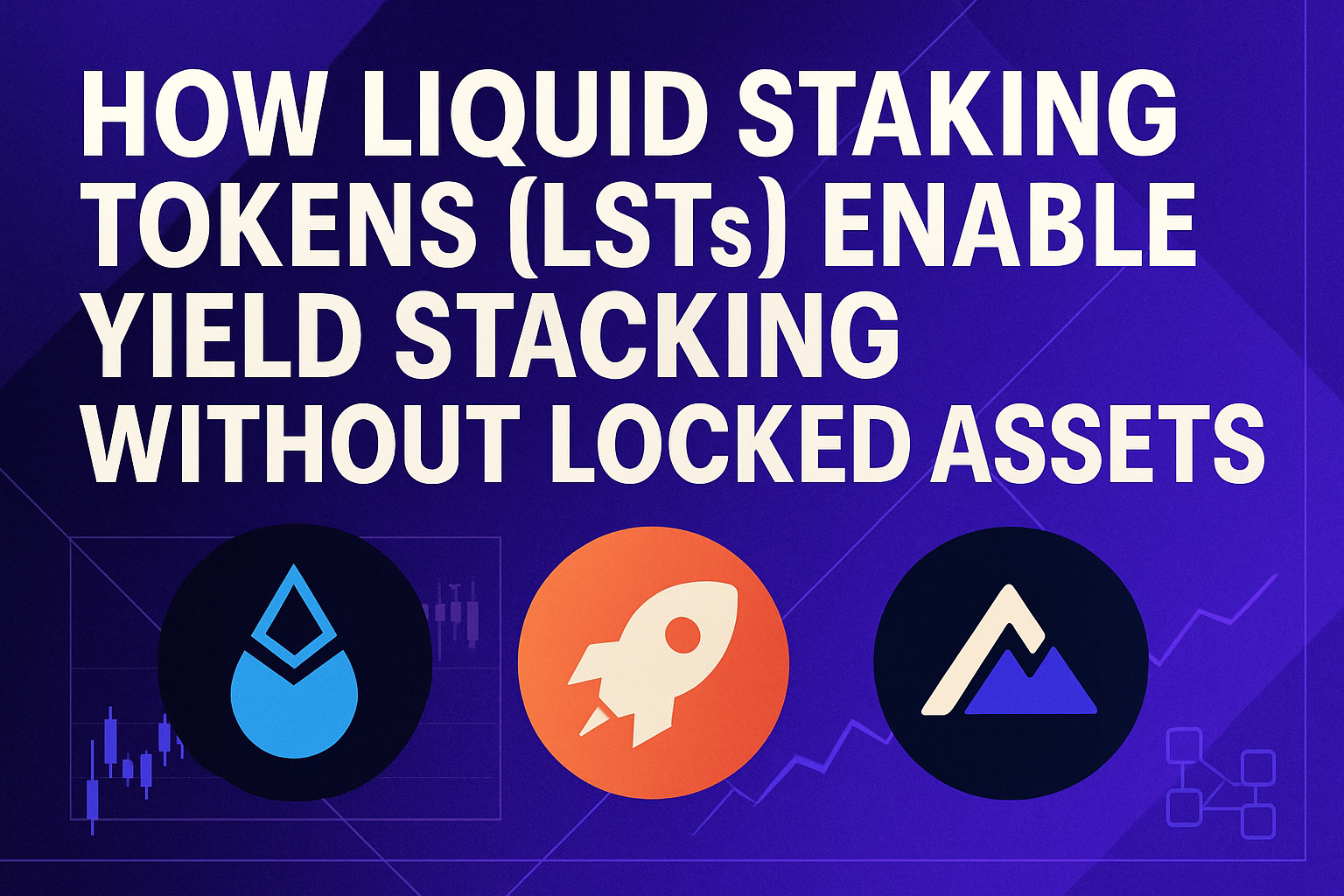
Liquid staking tokens (LSTs) have rapidly transformed the landscape of decentralized finance, offering a powerful solution for investors seeking both yield and liquidity. Unlike traditional staking, where assets are locked and inaccessible for the duration of the staking period, LSTs unlock capital efficiency by allowing users to earn staking rewards while simultaneously leveraging their tokens across a range of DeFi protocols. This dual utility has catalyzed a new era of LST yield stacking, where users can pursue multiple streams of income without forfeiting access to their assets.
How Liquid Staking Tokens Work: Unlocking Yield Without Lockup
The core innovation behind liquid staking is deceptively simple: when you stake your assets with a protocol like Lido Finance, Rocket Pool, or Benqi Liquid Staking, you receive a liquid derivative token that represents your staked position. These LSTs, such as stETH (Lido), rETH (Rocket Pool), or sAVAX (Benqi): are freely transferable and tradable on secondary markets. They can be used as collateral in lending protocols, deposited into liquidity pools, or deployed in yield farming strategies.
This mechanism allows holders to continue earning the underlying network’s staking rewards, currently a popular strategy for Ethereum at its price of $3,294.26: while also putting their LSTs to work elsewhere in DeFi. As a result, users are no longer forced to choose between yield and liquidity; they can optimize both simultaneously.
Leading Protocols Enabling Yield Stacking Without Asset Lockup
Let’s examine three standout protocols driving this innovation:
- Lido Finance: The dominant player on Ethereum, Lido issues stETH when users stake ETH. stETH accrues staking rewards in real time and is widely accepted across DeFi platforms for lending, borrowing, and liquidity mining.
- Rocket Pool: Rocket Pool offers decentralized ETH staking with its rETH token. rETH maintains strong peg stability and is integrated into various DeFi protocols for additional yield opportunities.
- Benqi Liquid Staking: Focused on Avalanche’s PoS network, Benqi enables AVAX holders to stake and receive sAVAX, a liquid token usable throughout Avalanche’s expanding DeFi ecosystem.
Together these protocols have set the standard for capital efficiency in proof-of-stake networks while providing robust options for risk management and diversification.
The Mechanics of Yield Stacking With LSTs
The process begins with users depositing their native tokens (such as ETH or AVAX) into a liquid staking protocol. In return they receive an equivalent amount of LSTs reflecting both their principal and accrued rewards. These LSTs can then be utilized in several ways:
- Lending Markets: Supply your LSTs as collateral in lending platforms to earn interest or borrow other assets for further investment opportunities.
- Liquidity Pools: Pair your LST with other tokens in automated market makers (AMMs) to earn trading fees and sometimes additional incentives from protocol emissions.
- Yield Farming: Stake your LST-LP positions in farms that offer extra rewards on top of baseline yields.
This layered approach compounds returns by stacking yields from multiple sources, all while maintaining exposure to the original asset’s appreciation potential. For more advanced strategies built around these concepts, see our guide on how liquid staking tokens unlock advanced yield strategies in DeFi.
Ethereum (ETH) Price Prediction 2026-2031 in the Era of Liquid Staking Tokens (LSTs)
Professional outlook based on the growing adoption of LSTs, DeFi integration, and technical/fundamental analysis. All prices in USD.
| Year | Minimum Price | Average Price | Maximum Price | Annual % Change (Avg) | Market Scenario Insights |
|---|---|---|---|---|---|
| 2026 | $2,900 | $3,850 | $5,100 | +17% | LST adoption drives capital efficiency; potential for modest recovery after 2025 pullback. |
| 2027 | $3,300 | $4,400 | $6,200 | +14% | Continued DeFi and LST growth; regulatory clarity improves outlook, but volatility persists. |
| 2028 | $3,900 | $5,150 | $7,800 | +17% | Major network upgrades and institutional adoption; ETH demand surges as LSTs become mainstream collateral. |
| 2029 | $4,500 | $6,200 | $9,500 | +20% | Bullish cycle fueled by global staking, ETH used as backbone of DeFi/LST ecosystem. |
| 2030 | $5,200 | $7,300 | $11,800 | +18% | Peak of bullish cycle; LSTs and ETH widely integrated in traditional finance, but risks of overheated market. |
| 2031 | $4,800 | $6,600 | $10,500 | -10% | Market correction following cycle peak; LSTs provide downside protection but broader crypto market adjusts. |
Price Prediction Summary
Ethereum is poised for significant growth through 2030, driven by the proliferation of liquid staking tokens (LSTs) and their integration into both DeFi and traditional finance. The ability to stack yields without locking assets enhances ETH’s utility and demand, supporting a progressive price appreciation. However, the market remains cyclical, with potential corrections post-2030 as bullish sentiment cools. Minimum and maximum ranges account for both regulatory and technical risks, as well as macroeconomic factors.
Key Factors Affecting Ethereum Price
- Rapid adoption of LSTs enhancing ETH liquidity and utility.
- Ongoing Ethereum network upgrades (scalability, security).
- Integration of ETH/LSTs into DeFi and TradFi applications.
- Regulatory changes impacting staking and DeFi protocols.
- Competition from other smart contract platforms.
- Global macroeconomic conditions and digital asset adoption.
- Smart contract and protocol security risks (e.g., depegging, exploits).
Disclaimer: Cryptocurrency price predictions are speculative and based on current market analysis.
Actual prices may vary significantly due to market volatility, regulatory changes, and other factors.
Always do your own research before making investment decisions.
Risk management remains a central consideration in any yield stacking strategy. While protocols like Lido Finance, Rocket Pool, and Benqi Liquid Staking have established strong reputations, users must remain vigilant about smart contract security, validator reliability, and market peg stability. For instance, stETH and rETH typically trade close to the price of ETH (currently $3,294.26), but extreme market events can cause temporary depegging, potentially impacting liquidity or creating arbitrage opportunities for sophisticated participants.
Another key advantage of these protocols is their composability across chains and DeFi platforms. Lido’s stETH is accepted by major lending markets such as Aave and Curve, enabling users to borrow stablecoins or participate in leveraged strategies without un-staking their ETH. Rocket Pool’s rETH is integrated with decentralized exchanges and collateralized lending solutions, offering flexibility for both passive holders and active traders. On Avalanche, Benqi’s sAVAX token unlocks similar utility for AVAX holders, fueling a vibrant ecosystem of liquidity pools and lending platforms native to the Avalanche network.

Considerations for Sustainable Yield Stacking
While the prospect of stacking multiple yields is enticing, sustainable returns require careful portfolio construction. Diversifying across multiple protocols, such as combining stETH from Lido with rETH from Rocket Pool or sAVAX from Benqi, can help mitigate risks specific to any one provider or blockchain. Monitoring protocol updates, governance changes, and security audits is also essential for long-term success.
For those new to liquid staking DeFi or seeking to optimize their approach further, our step-by-step guide on how to maximize yield stacking with liquid staking tokens (LSTs) in 2024 provides actionable insights tailored to current market conditions.
The Future of Liquid Staking: Evolving Opportunities
The rapid adoption of liquid staking tokens is redefining what it means to earn passive income in crypto. As more protocols integrate LSTs into their core products, and as DeFi matures with new risk management primitives, the boundaries between staking rewards and active yield generation will continue to blur. We are already seeing experimentation with cross-chain liquid staking solutions and modular vaults that automate complex yield stacking strategies for users.
The current Ethereum price at $3,294.26 underscores the growing demand for flexible capital deployment. As both institutional players and retail investors seek ways to maximize returns without sacrificing liquidity or security, the role of leading protocols like Lido Finance, Rocket Pool, and Benqi Liquid Staking will only become more prominent.
Ultimately, liquid staking tokens empower a new generation of DeFi participants to unlock sustainable returns while retaining control over their assets, a paradigm shift that is likely here to stay.


